Identification of Moving Load Characteristic on Pavement Using F-P Cavity Fiber Optical Technology
Abstract
:1. Introduction
2. Operational Principle and Sensor Design
2.1. Principle of F-P Cavity Tunable Filter
2.2. Sensor Unit Design
2.3. Package Structure Design
3. Laboratory Testing and Evaluation
3.1. Experiment Arrangement
3.2. Loading Experiment
3.3. Temperature Experiment
3.4. Results and Evaluation
4. Field Application
4.1. Field Testing Setup
4.2. Field Testing Data Acquisition
4.3. Field Load Estimation Algorithm
4.4. Field Testing Results
5. Conclusions
- (1)
- The sensor consisting of several sensor units can measure the vertical load from 0 to 160 kN. The linear correlation coefficient of the measured value is 93.32%. The sensor has a linear relationship with temperature changes and the coefficient is 99.5%, so temperature errors can be effectively avoided through temperature compensation.
- (2)
- Field application validates that the sensor has a weighing measurement error of 5.54% and an axis number measurement accuracy of 97.1%. The speed affects the measurement accuracy, but the influence can be ignored.
- (3)
- Field application shows that the output of each sensor unit decreases as the distance from the loading center increases. According to the comparison of the output of different sensor units, the location detection resolution is 300 mm.
Author Contributions
Funding
Data Availability Statement
Acknowledgments
Conflicts of Interest
References
- Chen, F.; Song, M.; Ma, X. A lateral control scheme of autonomous vehicles considering pavement sustainability. J. Clean. Prod. 2020, 256, 120669. [Google Scholar] [CrossRef]
- Meyer, G.; Beiker, S. Road Vehicle Automation 5; Springer: Berlin/Heidelberg, Germany, 2019; ISBN 978-3-319-94895-9. [Google Scholar]
- Kilburn, P. Alberta Infrastructure & Transportation Weigh in Motion Report; Alberta Transportation: Admonton, AL, USA, 2005. [Google Scholar]
- Wyman, J.; Braley, G.; Stevens, R. Field Evaluation of FHWA Vehicle Classification Categories—MDOT. Executive summary. In States’ Successful Practices Weigh-In-Motion Handbook 1984; McCall, B., Vodrazka, W.C., Jr., Eds.; Federal Highway Administration: Washington, DC, USA, 1997. [Google Scholar]
- Roh, H.-J. Spatial Transferability Testing of Dummy Variable Winter Weather Model Using Traffic Data Collected from Five Geographically Dispersed Weigh-in-Motion Sites in Alberta Highway Systems. J. Transp. Eng. Part A Syst. 2020, 146, 04020128. [Google Scholar] [CrossRef]
- Roh, H.-J. Developing Cold Region Winter Weather Traffic Models and Testing Their Temporal Transferability and Model Specification. J. Cold Reg. Eng. 2019, 33, 04019009. [Google Scholar] [CrossRef]
- Ferguson, A. Weighing vehicles in motion. Meas. Control. 1969, 2, T214–T222. [Google Scholar] [CrossRef]
- Koniditsiotis, C. Weigh-in-Motion Technology; Austroads Incorporated: Sydney, Australia, 2000. [Google Scholar]
- Jia, Z.; Fu, K.; Lin, M. Tire-Pavement Contact-Aware Weight Estimation for Multi-Sensor WIM Systems. Sensors 2019, 19, 2027. [Google Scholar] [CrossRef] [Green Version]
- Ali, N.; Trogdon, J.; Bergan, A.T. Evaluation of piezoelectric weigh-in-motion system. Can. J. Civ. Eng. 1994, 21, 156–160. [Google Scholar] [CrossRef]
- Cheng, L.; Zhang, H.; Li, Q. Design of a Capacitive Flexible Weighing Sensor for Vehicle WIM System. Sensors 2007, 7, 1530–1544. [Google Scholar] [CrossRef] [Green Version]
- Richardson, J.; Jones, S.; Brown, A.; Hajializadeh, D.; Obrien, E.J. On the use of bridge weigh-in-motion for overweight truck enforcement. Int. J. Heavy Veh. Syst. 2014, 21, 83. [Google Scholar] [CrossRef]
- Zhang, W.; Li, C.-L.; Di, X.-F.; Chen, M.; Tao, S. Research on Automotive Dynamic Weighing Method Based on Piezoelectric Sensor. MATEC Web Conf. 2017, 139, 203. [Google Scholar] [CrossRef] [Green Version]
- Zhao, Q.; Wang, L.; Zhao, K.; Yang, H. Development of a Novel Piezoelectric Sensing System for Pavement Dynamic Load Identification. Sensors 2019, 19, 4668. [Google Scholar] [CrossRef] [Green Version]
- Alavi, S.H.; Mactutis, J.A.; Gibson, S.D.; Papagiannakis, A.T.; Reynaud, D. Performance Evaluation of Piezoelectric Weigh-in-Motion Sensors under Controlled Field-Loading Conditions. Transp. Res. Rec. J. Transp. Res. Board 2001, 1769, 95–102. [Google Scholar] [CrossRef]
- Song, S.; Hou, Y.; Guo, M.; Wang, L.; Tong, X.; Wu, J. An investigation on the aggregate-shape embedded piezoelectric sensor for civil infrastructure health monitoring. Constr. Build. Mater. 2016, 131, 57–65. [Google Scholar] [CrossRef]
- Xiong, H.; Zhang, Y. Feasibility Study for Using Piezoelectric-Based Weigh-In-Motion (WIM) System on Public Roadway. Appl. Sci. 2019, 9, 3098. [Google Scholar] [CrossRef] [Green Version]
- Jiang, X.; Vaziri, S.H.; Haas, C.; Rothenburg, L.; Kennepohl, G.; Haas, R. Improvements in piezoelectric sensors and WIM data collection technology. In Proceedings of the 2009 Annual Conference of the Transportation Association of Canada, Vancouver, BC, Canada, 18–21 October 2009. [Google Scholar]
- Burnos, P.; Gajda, J. Thermal Property Analysis of Axle Load Sensors for Weighing Vehicles in Weigh-in-Motion System. Sensors 2016, 16, 2143. [Google Scholar] [CrossRef] [PubMed]
- Liu, P.; Zhao, Q.; Yang, H.; Wang, D.; Oeser, M.; Wang, L.; Tan, Y. Numerical Study on Influence of Piezoelectric Energy Harvester on Asphalt Pavement Structural Responses. J. Mater. Civ. Eng. 2019, 31, 04019008. [Google Scholar] [CrossRef]
- Xiang, T.; Huang, K.; Zhang, H.; Zhang, Y.; Zhang, Y.; Zhou, Y. Detection of Moving Load on Pavement Using Piezoelectric Sensors. Sensors 2020, 20, 2366. [Google Scholar] [CrossRef]
- Jacob, B.; Cottineau, L.-M. Weigh-in-motion for Direct Enforcement of Overloaded Commercial Vehicles. Transp. Res. Procedia 2016, 14, 1413–1422. [Google Scholar] [CrossRef] [Green Version]
- Lydon, M.; Robinson, D.; Taylor, S.E.; Amato, G.; O Brien, E.J.; Uddin, N. Improved axle detection for bridge weigh-in-motion systems using fiber optic sensors. J. Civ. Struct. Heal. Monit. 2017, 7, 325–332. [Google Scholar] [CrossRef] [Green Version]
- Berardis, S.; Caponero, M.A.; Felli, F.; Rocco, F. Use of FBG sensors for weigh in motion. In Proceedings of the 17th International Conference on Optical Fibre Sensors, Bruges, Belgium, 23–27 May 2005; pp. 695–698. [Google Scholar]
- Zahid, M.N.; Jiang, J.; Rizvi, S. Reflectometric and interferometric fiber optic sensor’s principles and applications. Front. Optoelectron. 2019, 12, 215–226. [Google Scholar] [CrossRef]
- Malla, R.B.; Sen, A.; Garrick, N.W. A Special Fiber Optic Sensor for Measuring Wheel Loads of Vehicles on Highways. Sensors 2008, 8, 2551–2568. [Google Scholar] [CrossRef] [Green Version]
- Yuksel, K.; Kinet, D.; Chah, K.; Caucheteur, C. Implementation of a Mobile Platform Based on Fiber Bragg Grating Sensors for Automotive Traffic Monitoring. Sensors 2020, 20, 1567. [Google Scholar] [CrossRef] [PubMed] [Green Version]
- Al-Tarawneh, M.; Huang, Y.; Lu, P.; Bridgelall, R. Weigh-In-Motion System in Flexible Pavements Using Fiber Bragg Grating Sensors Part A: Concept. IEEE Trans. Intell. Transp. Syst. 2019, 21, 5136–5147. [Google Scholar] [CrossRef]
- Ou, Y.; Cui, F.; Sun, Y. Tunable Filter with Micromachine F-P Cavity on the Silicon. Opt. Des. Test. 2002, 4927, 857–863. [Google Scholar] [CrossRef]
- Hou, W.-T.; Zhao, X. Response analysis of saturated asphalt pavement under action of moving load. Highw. Eng. 2012, 21, 12–15. [Google Scholar]
- Li, H. Dynamics of Pavement Structure Under the Interaction of Vehicles and Pavement; Beijing Jiaotong University: Beijing, China, 2011. [Google Scholar]
- Dong, Z.; Tan, Y.; Ou, J. Dynamic response analysis of asphalt pavement under three-directional nonuniform moving load. China Civ. Eng. J. 2013, 46, 122–130. [Google Scholar]
- Sun, J.S.; Xiao, T.; Yang, C.F.; Sun, J.C. Study on the Axle Load Conversion Formula for Asphalt Pavement Based on Actually Measured Deflection Equivalent. In Proceedings of the International Conference on Civil Engineering and Transportation (ICCET 2011), Jinan, China, 14–16 October 2011; p. 271. [Google Scholar]
- Chatterjee, I.; Liao, C.-F.; Davis, G.A. A statistical process control approach using cumulative sum control chart analysis for traffic data quality verification and sensor calibration for weigh-in-motion systems. J. Intell. Transp. Syst. 2016, 21, 111–122. [Google Scholar] [CrossRef]
- Mitchell, M.R.; Link, R.E.; Papagiannakis, A.T. High Speed Weigh-in-Motion Calibration Practices. J. Test. Eval. 2010, 38, 1–21. [Google Scholar] [CrossRef]
- Bajwa, R.; Coleri, E.; Rajagopal, R.; Varaiya, P.; Flores, C. Development of a cost-effective wireless vibration Weigh-in-motion system to estimate axle weights of trucks. Comput. Aided Civ. Infrastruct. Eng. 2017, 32, 443–457. [Google Scholar] [CrossRef]
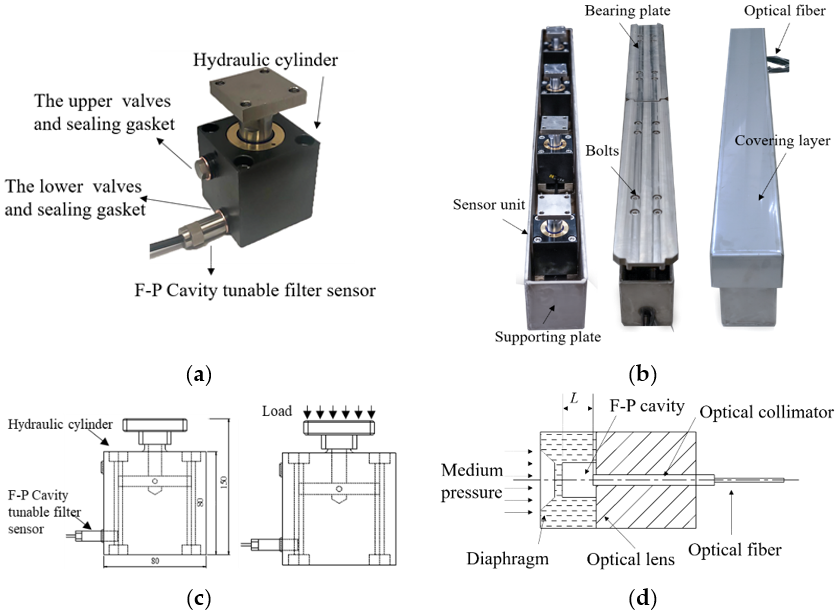
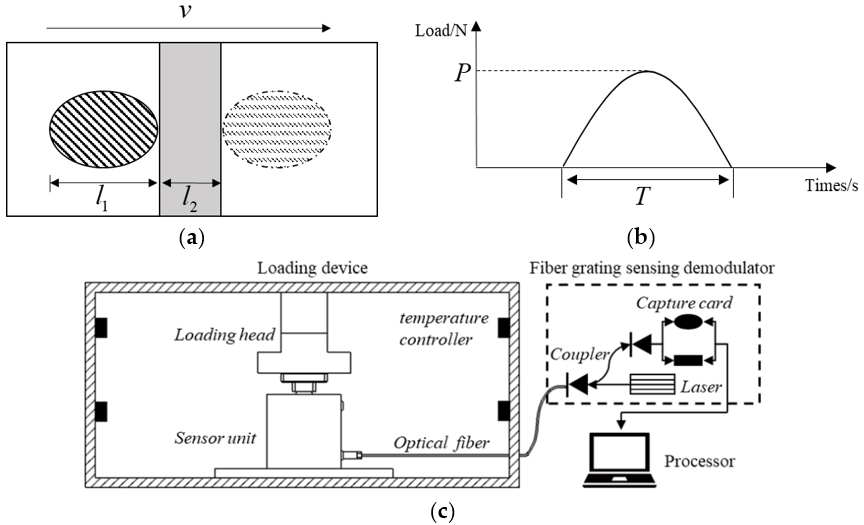
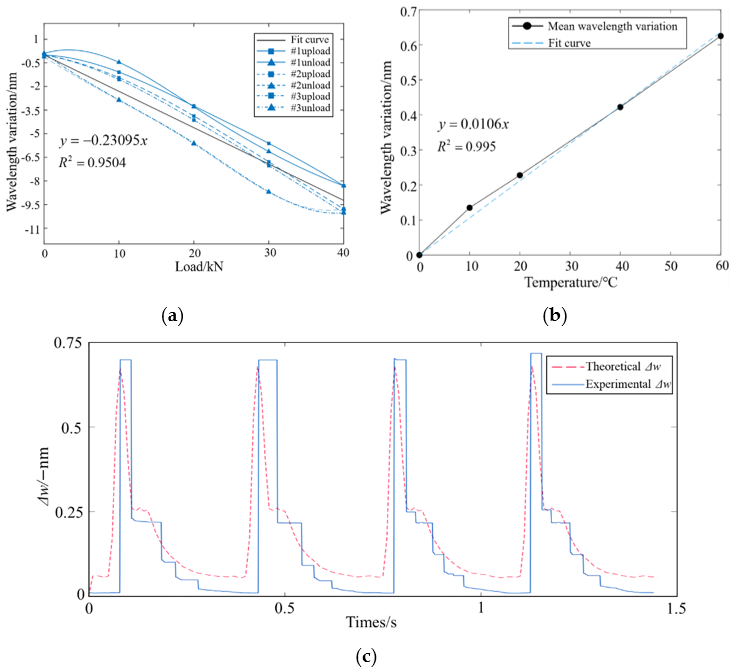

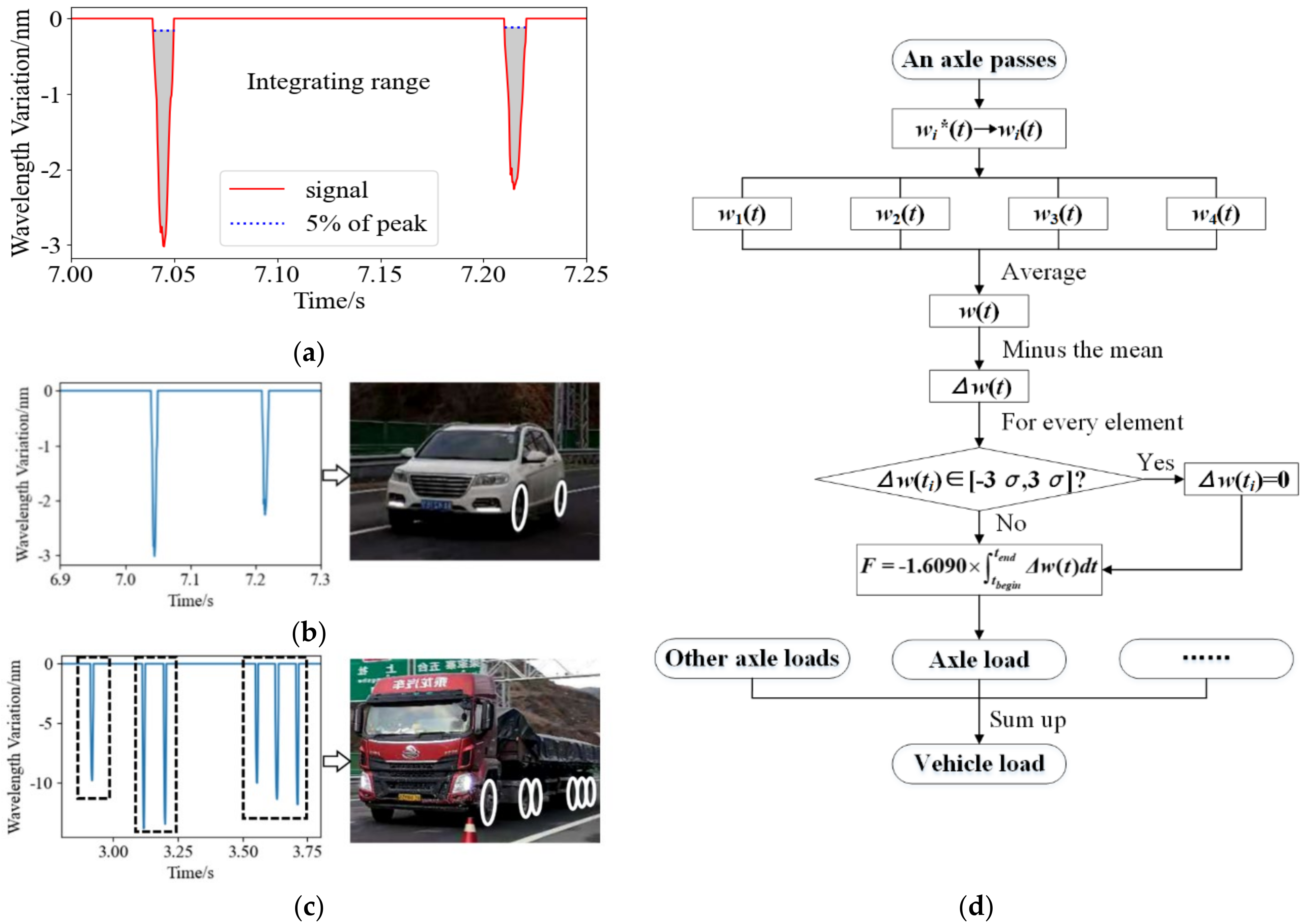
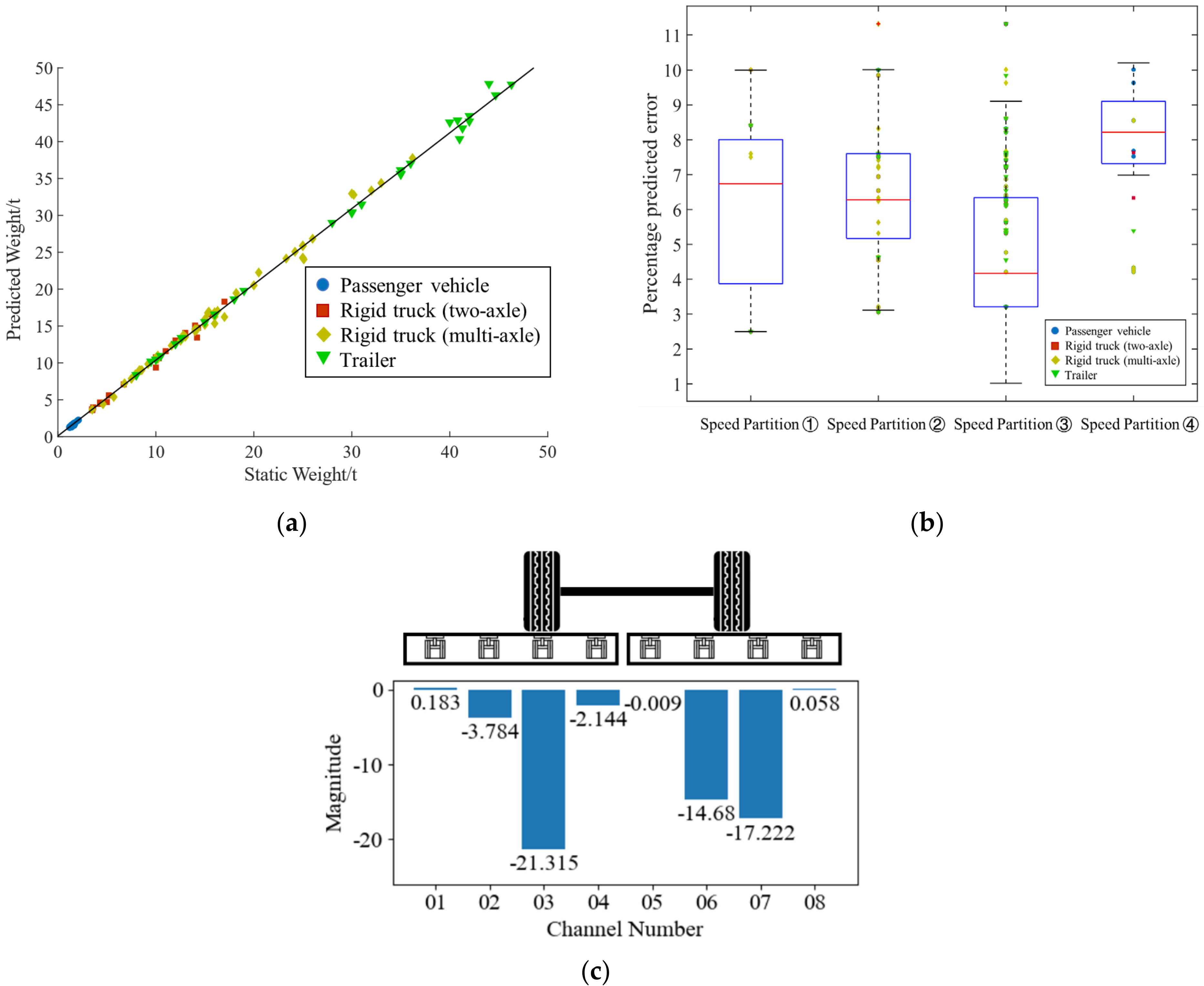
| Load/kN | Vertical Displacement/mm |
|---|---|
| 0 | 0.00 |
| 10 | 0.04 |
| 20 | 0.08 |
| 30 | 0.16 |
| 40 | 0.24 |
| Vehicle Type | Speed Partition ① (5~30 km/h) | Speed Partition ② (30~60 km/h) | Speed Partition ③ (60~90 km/h) | Speed Partition ④ (90~km/h) | Number |
|---|---|---|---|---|---|
| Passenger vehicle | 2 | 10 | 28 | 7 | 47 |
| Rigid truck (two-axle) | 3 | 9 | 11 | 2 | 25 |
| Rigid truck (multi-axle) | 5 | 19 | 20 | 4 | 48 |
| Trailer | 2 | 5 | 25 | 1 | 33 |
| Total | 12 | 43 | 84 | 14 | 153 |
| Vehicle Type | Mean Error of Vehicle Weight | Standard Deviation of Predicted Errors | Accuracy of Axle Number |
|---|---|---|---|
| Passenger vehicle | 7.12% | 1.82% | 97.3% |
| Rigid truck (two-axle) | 5.94% | 1.89% | 100.0% |
| Rigid truck (multi-axle) | 5.15% | 2.19% | 95.7% |
| Trailer | 3.47% | 1.86% | 96.4% |
| Total | 5.54% | 2.36% | 97.1% |
| WIM System | System ($) | Labor ($) | Error |
|---|---|---|---|
| F-P WIM (presented) | 6076 | 6500 | ±5.54% |
| Bending plate | 21,500 | 13,500 | ±10% |
| Strip WIM (piezoelectric) | 13,500 | 6500 | ±15% |
| Single load cell | 50,500 | 20,800 | ±6% |
Publisher’s Note: MDPI stays neutral with regard to jurisdictional claims in published maps and institutional affiliations. |
© 2022 by the authors. Licensee MDPI, Basel, Switzerland. This article is an open access article distributed under the terms and conditions of the Creative Commons Attribution (CC BY) license (https://creativecommons.org/licenses/by/4.0/).
Share and Cite
Zhao, C.; Bian, Z.; Zhao, H.; Ma, L.; Guo, M.; Peng, K.; Gao, E. Identification of Moving Load Characteristic on Pavement Using F-P Cavity Fiber Optical Technology. Sustainability 2022, 14, 2398. https://doi.org/10.3390/su14042398
Zhao C, Bian Z, Zhao H, Ma L, Guo M, Peng K, Gao E. Identification of Moving Load Characteristic on Pavement Using F-P Cavity Fiber Optical Technology. Sustainability. 2022; 14(4):2398. https://doi.org/10.3390/su14042398
Chicago/Turabian StyleZhao, Cai, Zeying Bian, Hongduo Zhao, Lukuan Ma, Mu Guo, Kedi Peng, and Erli Gao. 2022. "Identification of Moving Load Characteristic on Pavement Using F-P Cavity Fiber Optical Technology" Sustainability 14, no. 4: 2398. https://doi.org/10.3390/su14042398
APA StyleZhao, C., Bian, Z., Zhao, H., Ma, L., Guo, M., Peng, K., & Gao, E. (2022). Identification of Moving Load Characteristic on Pavement Using F-P Cavity Fiber Optical Technology. Sustainability, 14(4), 2398. https://doi.org/10.3390/su14042398







